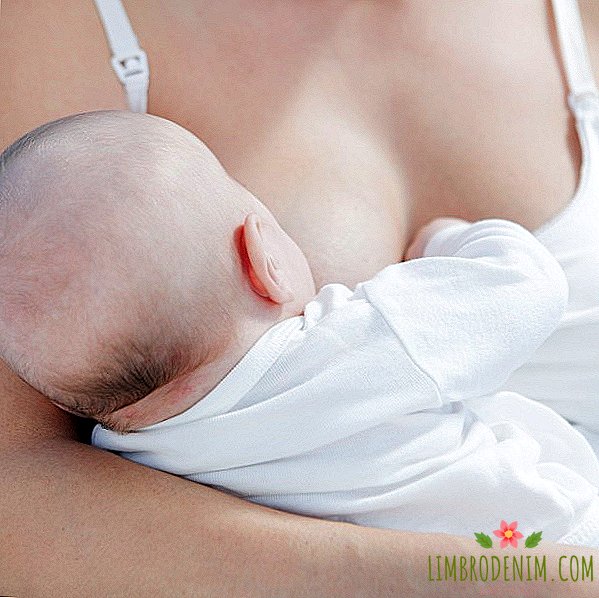Why breastfeeding in public is normal
Public feeding campaigns happen in the world regularly, and from August 1 to August 7 there is a week of breastfeeding in the world. Sometimes situations become a pretext for actions in which women faced with open condemnation or aggression claim their rights. Sometimes - positive examples of celebrity or suddenly collecting many likes of photos of open public feeding. But in this and in another case the question is posed sharply: how well is it to breastfeed in public?

In the West, the right of women to feed in public places is legally established: the relevant anti-discrimination laws are in effect in most countries of Europe, Great Britain, Australia, the USA and Canada. This means that a person who condemns or interferes with public breastfeeding may be brought before a court and, most likely, the court will take a decision not in his favor. Russia also belongs to those countries where breastfeeding in public places is not regulated by the law in any way. On the one hand, this means that no one can forbid a woman to breastfeed a child in a restaurant, park or shopping center. On the other hand, that in the case of censure, comments or sidelong glances, Russian women have no opportunity to rely on the letter of the law to prove to others that they do not do anything "indecent" and do not violate any administrative rules of conduct in public places.
In fairness it should be noted that even in countries where the right to public feeding is reflected in the law, unpleasant incidents happen regularly. A nursing mother may be asked to leave or cover her breasts with a napkin, so as not to annoy other guests of the expensive hotel, and politicians make strange statements, equating breastfeeding in a public place to exhibitionism.
More often than not, such stories become the reason for the next protest rallies, where dozens of mothers go, ready to breastfeed, even under the gun of reporter cameras. It is not surprising that such behavior insults the opponents of public feeding only more, and during the debates they take an even tougher stance, demanding to "leave personal - personal" and "respect the rights of others not to see another's bare chest." Nevertheless, in Western countries, the majority of respondents say that they are not annoyed by the appearance of women feeding in public. For example, according to the statistics of the British The Independent, public breast-feeding is considered acceptable by 77% of respondents. The British show the lowest level of tolerance for feeding in a restaurant - there it does not irritate 59% of respondents, while 84% are ready to “allow” women to safely feed on the beach.
Similar results are shown by the Debate.org portal. 64% of respondents answered in the affirmative to the question of whether public feeding of a child is decent. It is curious that most commentators who oppose public breastfeeding suggest that mothers use a breast pump and feed the baby from the bottle. The option of using a diaper or a special cape was considered acceptable only by some opponents of public feeding.

In general, the position of those who censure public feeding, comes down to several arguments. Opponents of public feeding believe that it is indecent: in the process of feeding a woman publicly exposes her breasts, which violates the generally accepted norms of behavior. They also believe that public exposure of the breast can provoke sexual violence against a woman, they say that it can be unpleasant for others who do not want to see young children next to them and observe their physiological processes. Those who oppose public feeding say that this is an "intimate process," a "sacrament" and something that should only happen at home and behind closed doors, and also believe that it violates the borders of others.
Organizations involved in supporting breastfeeding point out that even in the most developed countries, women have a hard time precisely because of the possible reluctance of their opponents to admit that breastfeeding is a natural process, which has no obscene implications, and the female breast, like a nursing woman is not always a sexual object for those around her. They advocate demarginalization of public feeding, emphasizing that finding a child in the mother’s breast is the most normal state for him. La Leche League recommends that women preserve their dignity and remember that every mother who calmly feeds in public becomes an athlete for breastfeeding.
The organization also emphasizes several points in its newsletters. First, breastfeeding is recommended by WHO: pediatricians are urged to support the intent to breastfeed for up to two years in mothers, and for children under 6 months of age it is recommended to receive only breastmilk as food. This is a natural mechanism laid down by nature, and the benefits of this method of feeding babies are widely proven scientifically. It is also scientifically proven that the use of "breast replacers" (bottles, pacifiers) can adversely affect lactation and become a threat to the preservation of natural feeding.
Secondly, feeding is not only the process of eating. It is also a way to calm the child, support him, give him attention. In the first months of life, an infant who is exclusively breastfed has a natural need to attach to the breast often: the interval between application can be from 10 to 40 minutes - and this is the norm. An infant lacking the ability to attach itself to the breast, sharply increases the level of cortisol, it does not find the usual way to calm itself and is experiencing severe stress and physical suffering. Thirdly, it is convenient for the mother, since the child on the chest is calm (or quickly calms down), does not experience stress, does not cry and does not attract the attention of others. In addition, mothers with unsteady lactation (this period often lasts the first 3-5 months after the birth of the child) may have frequent flushes of milk. In this case, it is physically necessary to attach the child to the breast: if this is not done, there is a serious risk of getting milk stagnation or an inflammatory process.

Nevertheless, even if you know that the majority is on your side, in such a delicate question, it may sometimes be enough to have a single disapproving comment or a not too approving glance. The situation is aggravated by the fact that in the European region, to which Russia is statistically related, is one of the lowest indicators of the duration of breastfeeding in the world. Attitude to public feeding is calibrated by two factors: the average duration of breastfeeding (the longer it is, the more relaxed the public feeding is) and the general level of tolerance and openness. In Europe, a high level of tolerance, but a very short duration of feeding - on average 1-3 months, depending on the country. Scandinavia stands apart: there is more time there, since mothers are entitled to long-term paid leave to care for a child, so many feed longer.
Historically, in the Western world, the feeding process, like everything related to the birth and raising of children, was an intra-family female affair. Among the nobility and the aristocracy, the tradition of “dairy motherhood” was widespread: the mothers themselves did not feed the children, for this purpose a special servant was employed - a nurse. Up to the end of the XVIII century in Europe (and even longer in Russia), the work of the wet nurse was one of the most popular among the lower class women; this gave the feeding process a “grassroots” status - it was impossible to publicly feed in a decent society, and even if a woman chose to feed her children herself, she did it only in a private setting.
In the 19th century, laws began to be passed in European countries obligating mothers to independently feed their children. At the same time, more and more enlightening works appeared, noting the value of breast milk, which contrasted it with artificial substitutes, which at that time were of rather poor quality.
The situation was changed by industrialization and partial equalization of women in rights with men. It became possible to give children into state nurseries, and this significantly affected the length of time breastfeeding - it has decreased dramatically. Public feeding did not cause fierce censure, but due to the massive spread of artificial mixtures and the fact that women needed to return to work as soon as possible, breastfeeding itself became completely unpopular.

In the framework of the communist ideology and the "new Soviet life", the status of a woman also did not imply long thoughtful motherhood: the woman should return to the status of a work unit as soon as possible. For this, all conditions were created: nurseries, dairy kitchens. As a result, weaning occurred at a very early age, and no alternative was assumed, since the conditions for the preservation of breastfeeding and its demarginalization were not created.
The popularity of breastfeeding and changing attitudes to it swept the world in the 60s: the West experienced a baby boom, hippies preached naturalness and closeness to nature, travel to third world countries and former colonies, where women fed and walk bare-footed, came into vogue . In the Soviet Union around the same time, a party directive was adopted to create conditions for supporting breastfeeding at work; nursing mothers with children under 1 year old had the right to shorten working time in favor of several feeding intervals, they began to build nurseries right in the factories so that women could leave for the children of necessity.
Scientific experience accumulated by this time stated that breast milk is by far the most useful form of food for babies. This statement was not questioned until about the end of the 80s, when a new wave of emancipation prompted women not to abandon their desire to concentrate on their careers, and the much more sophisticated formula for artificial feeding allowed them to reduce maternity leave to a minimum and continue working almost immediately after the appearance of the child. The popularity of long-term breastfeeding has begun to fall, despite WHO’s efforts to actively promote it in both developing and economically successful countries.
Breastfeeding in Russia today is not the norm. According to WHO statistics for 2006-2011, the average duration of exclusive breastfeeding infants in Russia is 1 month. It is not surprising that women who feed only breast milk and those who feed longer than six months may find it difficult to feel confident and aware that there is nothing marginal in public feeding: there are just too few such mothers to form. " most".
A modern resident of a large city even with a small child has the opportunity to lead an active lifestyle: go to restaurants and cafes, attend educational activities for mothers and babies, museums, shops, city events. All-wheelchair and convenient strollers, ergoperoshenki and a taxi with a car seat help moms to walk and have fun with their children - naturally, in such a situation, sooner or later there is a need to feed the child. A particular feature of breastfeeding is that the baby feels the need to attach to the breast more often than once every three hours, as is the case with the feeding mixture. Therefore, breastfeeding moms cannot avoid situations when feeding happens outside the home. Few people think about the fact that, if the feeding will take place only "behind closed doors", the woman will be obliged not to leave the house during the entire decree.
In Russian-speaking online communities for moms, the topic "decently / indecently" and "how others react" occurs regularly. In one of the recent posts from the closed facebook-community Momshare, one of the participants asked other mothers to tell about the cases of a sharply negative attitude towards public breastfeeding. The post collected more than a hundred comments, in 14 of them the participating mothers themselves had a negative attitude towards public feeding; about 10 women said that they openly (that is, not hiding behind a diaper, scarf or special cape) fed publicly and did not encounter negative, the rest (that is, about 75% of respondents) said that they were ready to feed and feed publicly only after covering themselves with a swaddling cloth or special cape, and consider this option the most convenient for themselves and others.
Indeed, the main solution for women who are not ready to face the condemnation of others, but want to be able to feed in a public place - to hide behind a diaper or special capes, to look for a secluded corner or room for feeding. Women who feed for a long time (for example, according to the precepts of WHO - up to two years), most often seek to explain to an older child that they can get access to the breast only in a private setting; their situation is further complicated by the fact that the older the child, the higher the risk of confronting misunderstanding and an open expression of censure.
It is easy to see that, in general, the attitude to public feeding in modern society strongly correlates with the attitude to the freedom of women to dispose of their bodies, to the need to identify and defend their own borders. No matter how strange it may sound, the public request to conceal the process of breastfeeding has much in common with the next generation: in both cases, women are forced to obey moral norms and ideas about what is good and what is bad. . Taboo to publicly use the breast according to its natural, nature-determined purpose is a sad consequence of sexual objectification: unfortunately, exposing the child to feed the child, the woman still runs the risk of being accused of demonstrating “sexual delights”, although on his own chest does not have. So, although women have already won the right to breast, someone still seeks to tell them how to use it properly.
Photo:juan_aunion - stock.adobe.com, juan_aunion - stock.adobe.com, Wikimedia (1, 2)





